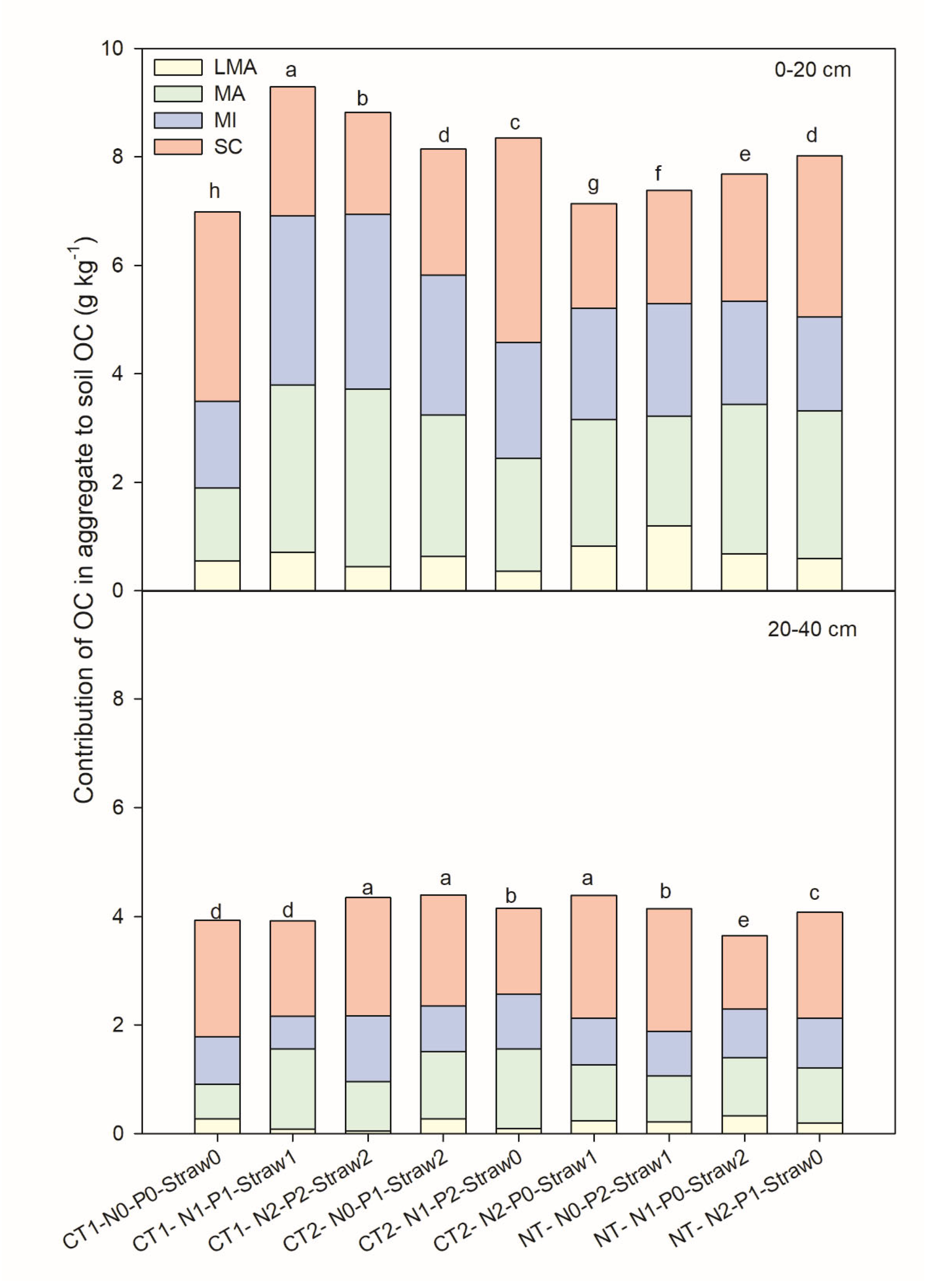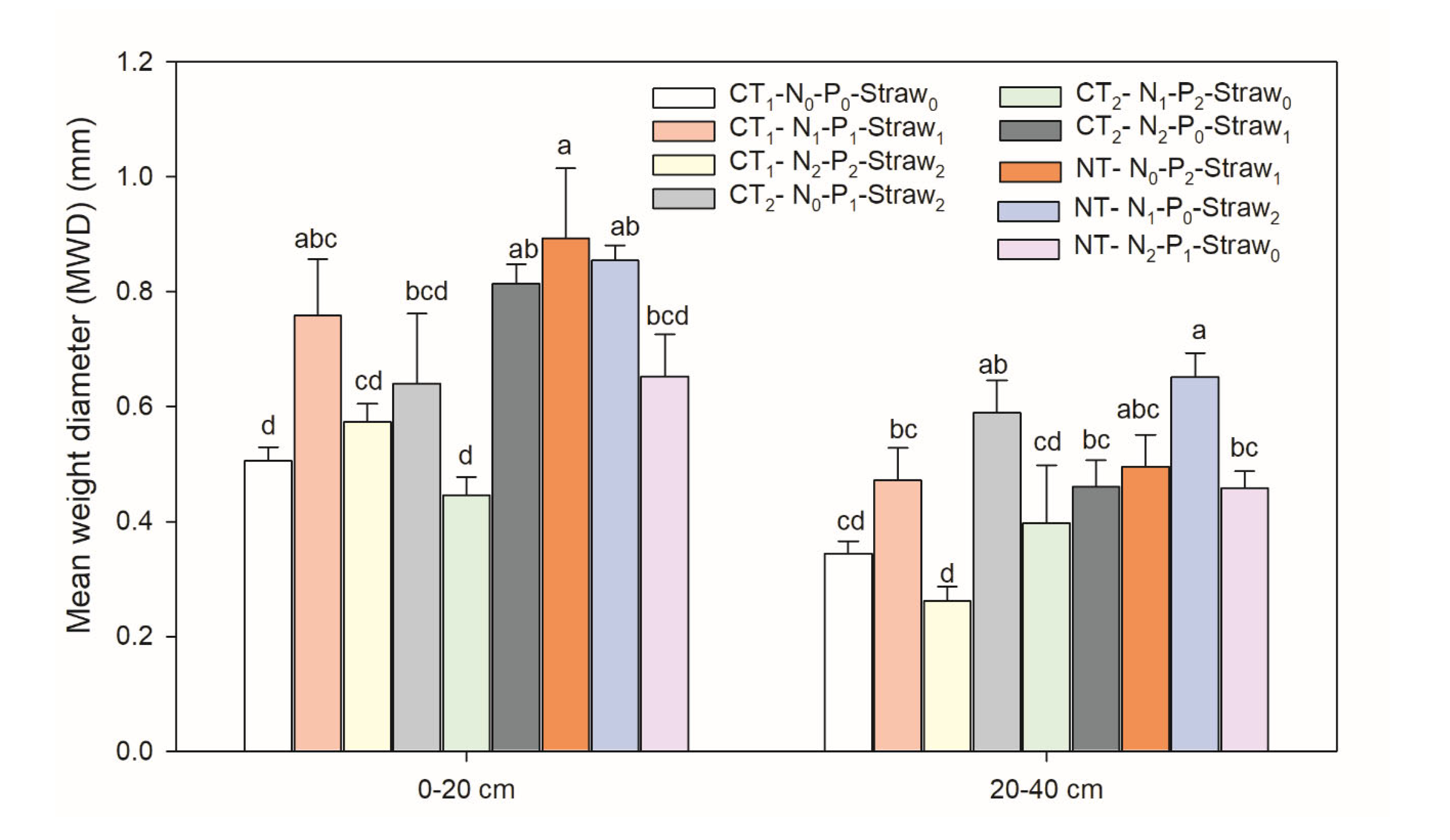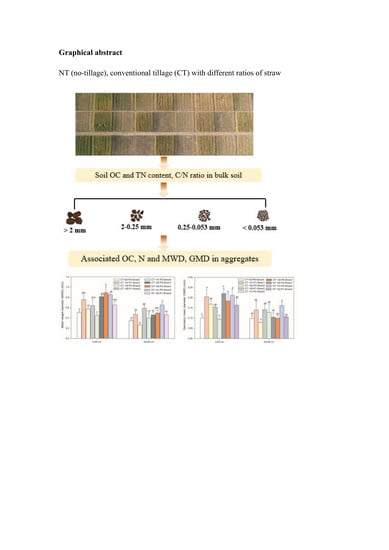Influence of Tillage, Straw-Returning and Mineral Fertilization on the Stability and Associated Organic Content of Soil Aggregates in the North China Plain
Abstract
1. Introduction
2. Materials and Methods
2.1. Study Sites
2.2. Experimental Design and Soil Sampling
2.3. Determination of Soil Water-Stable Aggregates
2.4. Analysis
3. Results
3.1. Effects of Tillage and Straw on the Mass Distribution of Aggregates
3.2. Soil and Water-Stable, Aggregate-Associated Organic Carbon Content
3.3. Soil and Water-Stable, Aggregate-Associated Nitrogen Content
3.4. Effects of Tillage and Fertilization on Aggregate Stability
3.5. C/N Ratios in Bulk Soil and Aggregates
4. Discussion
4.1. Effects of Tillage, Straw-Returning, and Mineral Fertilization on OC Content of Soil and Aggregates
4.2. Effects of Tillage, Straw-Returning, and Mineral Fertilizer on Nitrogen Contents
4.3. Effects of Tillage, Straw-Returning, and Mineral Fertilizer on Aggregate Stability
5. Conclusions
Author Contributions
Funding
Acknowledgments
Conflicts of Interest
References
- Sarker, J.R.; Singh, B.P.; Cowie, A.L.; Fang, Y.; Collins, D.; Badgery, W.; Dalal, R.C. Agricultural management practices impacted carbon and nutrient concentrations in soil aggregates, with minimal influence on aggregate stability and total carbon and nutrient stocks in contrasting soils. Soil Tillage Res. 2018, 178, 209–223. [Google Scholar] [CrossRef]
- Devine, S.; Markewitz, D.; Hendrix, P.; Coleman, D. Soil Aggregates and Associated Organic Matter under Conventional Tillage, No-Tillage, and Forest Succession after Three Decades. PLoS ONE 2014, 9, e84988. [Google Scholar] [CrossRef] [PubMed]
- Qin, S.; Wang, Y.; Hu, C.; Oenema, O.; Li, X.; Zhang, Y.; Dong, W. Yield-scaled N2O emissions in a winter wheat–summer corn double-cropping system. Atmos. Environ. 2012, 55, 240–244. [Google Scholar] [CrossRef]
- Liu, Z.; Sun, K.; Liu, W.; Gao, T.; Li, G.; Han, H.; Ning, T. Responses of soil carbon, nitrogen, and wheat and maize productivity to 10 years of decreased nitrogen fertilizer under contrasting tillage systems. Soil Tillage Res. 2020, 196, 104444. [Google Scholar] [CrossRef]
- Hou, R.X.; Ouyang, Z.; Li, Y.S.; Tyler, D.D.; Li, F.D.; Wilson, G.V. Effects of tillage and residue management on soil organic carbon and total nitrogen in the North China Plain. Soil Sci. Soc. Am. J. 2012, 76, 230. [Google Scholar] [CrossRef]
- Angers, D.A.; EriksenHamel, N.S. Full-inversion tillage and organic carbon distribution in soil profiles: A Meta-Analysis. Soil Sci. Soc. Am. J. 2008, 72, 1370–1374. [Google Scholar] [CrossRef]
- Luo, Z.K.; Wang, E.L.; Sun, O.J. Can no-tillage stimulate carbon sequestration in agricultural soils? A meta-analysis of paired experiments. Agric. Ecosyst. Environ. 2010, 139, 224–231. [Google Scholar] [CrossRef]
- Blanco-Canqui, H.; Lal, R.; Sartori, F.; Miller, R.O. Changes in Organic Carbon and Physical Properties of Soil Aggregates Under Fiber Farming. Soil Sci. 2007, 172, 553–564. [Google Scholar] [CrossRef]
- Luo, Z.; Wang, E.; Sun, O.J. Soil carbon change and its responses to agricultural practices in Australian agro-ecosystems: A review and synthesis. Geoderma 2010, 155, 211–223. [Google Scholar] [CrossRef]
- Six, J.; Bossuyt, H.; Degryze, S.; Denef, K. A history of research on the link between (micro) aggregates, soil biota, and soil organic matter dynamics. Soil Tillage Res. 2004, 79, 7–31. [Google Scholar] [CrossRef]
- Bronick, C.J.; Lal, R. Soil structure and management: A review. Geoderma 2005, 124, 3–22. [Google Scholar] [CrossRef]
- Blancocanqui, H.; Lal, R. Mechanisms of Carbon Sequestration in Soil Aggregates. Crit. Rev. Plant Sci. 2004, 23, 481–504. [Google Scholar] [CrossRef]
- Zhang, X.F.; Xin, X.L.; Zhu, A.N.; Zhang, J.B.; Yang, W.L. Effects of tillage and residue managements on organic C accumulation and soil aggregation in a sandy loam soil of the North China Plain. Catena 2017, 156, 176–183. [Google Scholar] [CrossRef]
- Tisdall, J.M.; Oades, J.M. Organic matter and water-stable aggregates in soils. Eur. J. Soil Sci. 2010, 33, 141–163. [Google Scholar] [CrossRef]
- Verchot, L.V.; Dutaur, L.; Shepherd, K.D.; Albrecht, A. Organic matter stabilization in soil aggregates: Understanding the biogeochemical mechanisms that determine the fate of carbon inputs in soils. Geoderma 2011, 161, 182–193. [Google Scholar] [CrossRef]
- Somasundaram, J.; Reeves, S.; Wang, W.; Heenan, M.; Dalal, R. Impact of 47 years of No-tillage and stubble retention on soil aggregation and Carbon distribution in a Vertisol: Impact of No till, stubble retention on soil aggregation and Carbon. Land Degrad. Dev. 2017, 28. [Google Scholar] [CrossRef]
- Candido, V.; Campanelli., G.; D’Addabbo, T.; Castronuovo, D.; Renco, M.; Camele, I. Growth and yield promoting effect of artificial mycorrhization combined with different fertilizer rates on field-grown tomato. Ital. J. Agron. 2013, 8, 168–174. [Google Scholar]
- Dou, X.; He, P.; Zhu, P.; Zhou, W. Soil organic carbon dynamics under long-term fertilization in a black soil of China: Evidence from stable C isotopes. Sci. Rep. 2016, 6, 21488. [Google Scholar] [CrossRef]
- Manna, M.C.; Swarup, A.; Wanjari, R.H.; Mishra, B.; Shahi, D.K. Long-term fertilization, manure and liming effects on soil organic matter and crop yields. Soil Tillage Res. 2007, 94, 397–409. [Google Scholar] [CrossRef]
- Du, Z.L.; Han, X.; Wang, Y.Q.; Gu, R.S.; Li, Y.C.; Wang, D.Y.; Yun, A.P.; Guo, L.P. Changes in soil organic carbon concentration, chemical composition, and aggregate stability as influenced by tillage systems in the semi-arid and semi-humid area of North China. Can. J. Soil Sci. 2018, 98, 0045. [Google Scholar] [CrossRef]
- Six, J.; Paustian, K. Aggregate-associated soil organic matter as an ecosystem property and a measurement tool. Soil Biol. Biochem. 2014, 68, A4–A9. [Google Scholar] [CrossRef]
- Puget. Soil organic carbon and nitrogen in a Mollisol in central Ohio as affected by tillage and land use. Soil Tillage Res. 2005, 80, 201–213. [Google Scholar] [CrossRef]
- Gajic, B.; Tapanarova, A.; Tomic, Z.; Kresovic, B.; Vujovic, D.; Pejic, B. Land use effects on aggregation and erodibility of Luvisols on undulating slopes. Aust. J. Crop Sci. 2013, 7, 1198–1204. [Google Scholar]
- Mclauchlan, K.K.; Hobbie, S.E. Comparison of labile soil organic matter ractionation techniques. Soil Sci. Soc. Am. J. 2004, 68, 1616–1625. [Google Scholar] [CrossRef]
- John, B.; Yamashita, T.; Ludwig, B.; Flessa, H. Storage of organic carbon in aggregate and density fractions of silty soils under different types of land use. Geoderma 2005, 128, 63–79. [Google Scholar] [CrossRef]
- Tian, S.Z.; Ning, T.Y.; Wang, Y.; Liu, Z.; Li, G.; Li, Z.J.; Lal, R. Crop yield and soil carbon responses to tillage method changes in North China. Soil Tillage Res. 2016, 163, 207–213. [Google Scholar] [CrossRef]
- Pradhan, A.; Chan, C.; Roul, P.K.; Halbrendt, J.; Sipes, B. Potential of conservation agriculture (CA) for climate change adaptation and food security under rainfed uplands of India: A transdisciplinary approach. Agric. Syst. 2017, 163, 27–35. [Google Scholar] [CrossRef]
- Cowie, A.L.; Lonergan, V.E.; Rabbi, S.M.F.; Fornasier, F.; Macdonald, C.; Harden, S.; Kawasaki, A.; Singh, B.K. Impact of carbon farming practices on soil carbon in northern New South Wales. Soil Res. 2014, 51, 707–718. [Google Scholar] [CrossRef]
- Rabbi, S.M.F.; Wilson, B.R.; Lockwood, P.V.; Daniel, H.; Young, I.M. Soil organic carbon mineralization rates in aggregates under contrasting land uses. Geoderma 2014, 216, 10–18. [Google Scholar] [CrossRef]
- Young, J.C.; Thompson, D.B.A.; Moore, P.; Macgugan, A.; Watt, A.; Redpath, S.M. A conflict management tool for conservation agencies. J. Appl. Ecol. 2016, 53, 705–711. [Google Scholar] [CrossRef]
- Dalal, R.C.; Allen, D.E.; Wang, W.J.; Reeves, S.; Gibson, I. Organic carbon and total nitrogen stocks in a Vertisol following 40 years of no-tillage, crop residue retention and nitrogen fertilization. Soil Tillage Res. 2011, 112, 133–139. [Google Scholar] [CrossRef]
- Kopittke, P.M.; Dalal, R.C.; Finn, D.; Menzies, N.W. Global changes in soil stocks of carbon, nitrogen, phosphorus, and sulphur as influenced by long-term agricultural production. Glob. Chang. Biol. 2017, 23, 2509–2519. [Google Scholar] [CrossRef]
- Zhang, X.; Zhu, A.; Xin, X.; Yang, W.; Zhang, J.; Ding, S. Tillage and residue management for long-term wheat-maize cropping in the North China Plain: I. Crop yield and integrated soil fertility index. Field Crop. Res. 2018, 221, 157–165. [Google Scholar] [CrossRef]
- Bhattacharyya, R.; Tuti, M.D.; Kundu, S.; Bisht, J.K.; Bhatt, J.C. Conservation Tillage Impacts on Soil Aggregation and Carbon Pools in a Sandy Clay Loam Soil of the Indian Himalayas. Soil Sci. Soc. Am. J. 2012, 76, 617–627. [Google Scholar] [CrossRef]
- Six, J.; Elliott, E.T.; Paustian, K. The potential to mitigate global warming with no-tillage management is only realized when practised in the long term. Glob. Chang. Biol. 2010, 10, 155–160. [Google Scholar] [CrossRef]
- Abid, M.; Lal, R. Tillage and drainage impact on soil quality: I. Aggregate stability, carbon and nitrogen pools. Soil Tillage Res. 2008, 100, 89–98. [Google Scholar] [CrossRef]
- Jiang, X.; Hu, Y.; Bedell, J.H.; Xie, D.; Wright, A.L. Soil organic carbon and nutrient content in aggregate-size fractions of a subtropical rice soil under variable tillage. Soil Use Manag. 2010, 27, 28–35. [Google Scholar] [CrossRef]
- Dexter A, R. Advances in characterization of soil structure. Soil Tillage Res. 1988, 11, 199–238. [Google Scholar] [CrossRef]
- Jiang, X.; Wright, A.L.; Wang, J.; Li, Z. Long-term tillage effects on the distribution patterns of microbial biomass and activities within soil aggregates. Catena 2011, 87, 276–280. [Google Scholar] [CrossRef]
- Nakajima, T.; Shrestha, R.K.; Jacinthe, P.A.; Lal, R.; Bilen, S.; Dick, W. Soil organic carbon pools in ploughed and no-till Alfisols of central Ohio. Soil Use Manag. 2016, 32, 515–524. [Google Scholar] [CrossRef]
- Wang, J.; Wang, E.; Yang, X.; Zhang, F.; Hong, Y. Increased yield potential of wheat-maize cropping system in the North China Plain by climate change adaptation. Clim. Chang. 2012, 113, 825–840. [Google Scholar] [CrossRef]
- Kong, L. Maize residues, soil quality, and wheat growth in China. A review. Agron. Sustain. Dev. 2014, 34, 405–416. [Google Scholar] [CrossRef]
- Shu, X.; Zhu, A.N.; Zhang, J.B.; Yang, W.L.; Xin, X.L.; Zhang, X.F. Changes in soil organic carbon and aggregate stability after conversion to conservation tillage for seven years in the Huang-Huai-Hai Plain of China. J. Integr. Agric. 2015, 14, 1202–1211. [Google Scholar] [CrossRef]
- Six, J.; Feller, C.; Denef, K.; Ogle, S.M.; Sa, J.C.D.M.; Albrecht, A. Soil organic matter, biota and aggregation in temperate and tropical soils - Effects of no-tillage. Agronomie 2016, 22, 755–775. [Google Scholar] [CrossRef]
- Pittelkow, C.M.; Liang, X.; Linquist, B.A.; van Groenigen, K.J.; Lee, J.; Lundy, M.E. Productivity limits and potentials of the principles of conservation agriculture. Nature 2015, 517, 365–368. [Google Scholar] [CrossRef]
- Du, Z.L.; Ren, T.S.; Hu, C.S.; Zhang, Q.Z.; Blancocanqui, H. Soil aggregate stability and aggregate-associated carbon under different tillage systems in the North China Plain. J. Integr. Agric. 2013, 12, 2114–2123. [Google Scholar] [CrossRef]
- Ludwig, B.; Hu, K.; Niu, L.; Liu, X. Modelling the dynamics of organic carbon in fertilization and tillage experiments in the North China Plain using the Rothamsted Carbon Model—Initialization and calculation of C inputs. Plant Soil 2010, 332, 193–206. [Google Scholar] [CrossRef]
- Cambardella, C.A.; Elliott, E.T. Particulate soil organic-matter changes across a grassland cultivation sequence. Soil Sci. Soc. Am. J. 1993, 56, 777–783. [Google Scholar] [CrossRef]
- Nelson, D.W.; Sommers, L.E. Determination of Total Nitrogen in Plant Material. Agron. J. 1973, 65, 423–425. [Google Scholar] [CrossRef]
- Kemper, W.D.; Rosenau, R.C. Aggregate stability and size distribution. In Methods of Soil Analysis, Part 1, 2nd ed.; Klute, A., Ed.; American Society of Agronomy: Madison, WI, USA, 1986; pp. 837–871. [Google Scholar]
- Chen, Z.J.; Geng, S.C.; Zhang, J.H.; Setä, H.; Gu, Y.; Wang, F.; Zhang, X.; Wang, X.X.; Han, S.J. Addition of nitrogen enhances stability of soil organic matter in a temperate forest. Eur. J. Soil Sci. 2017, 68, 189–199. [Google Scholar] [CrossRef]
- Guo, Z.; Zhang, Z.; Zhou, H.; Wang, D.; Peng, X. The effect of 34-year continuous fertilization on the SOC physical fractions and its chemical composition in a Vertisol. Sci. Rep. 2019, 9, 2505. [Google Scholar] [CrossRef] [PubMed]
- Baker, J.M.; Ochsner, T.E.; Venterea, R.T.; Griffis, T.J. Tillage and soil carbon sequestration--What do we really know. Agric. Ecosyst. Environ. 2007, 118, 1–5. [Google Scholar] [CrossRef]
- Blanco-Moure, N.; Gracia, R.; Bielsa, A.C.; López, M.V. Long-term no-tillage effects on particulate and mineral-associated soil organic matter under rainfed Mediterranean conditions. Soil Use Manag. 2013, 29, 250–259. [Google Scholar] [CrossRef]
- Benbi, D.K.; Senapati, N. Soil aggregation and carbon and nitrogen stabilization in relation to residue and manure application in rice–wheat systems in northwest India. Nutr. Cycl. Agroecosyst. 2010, 87, 233–247. [Google Scholar] [CrossRef]
- Dai, J.; Wang, Z.; Li, M.; Gang, H.; Qiang, L.; Cao, H. Winter wheat grain yield and summer nitrate leaching: Long-term effects of nitrogen and phosphorus rates on the Loess Plateau of China. Field Crops Res. 2016, 196, 180–190. [Google Scholar] [CrossRef]
- Yan, G.Y.; Xing, Y.J.; Han, S.J.; Zhang, J.H.; Wang, Q.G.; Mu, C. Long-time precipitation reduction and nitrogen deposition increase alter soil nitrogen dynamic by influencing soil bacterial communities and functional groups. Pedosphere 2020, 30, 363–377. [Google Scholar] [CrossRef]
- Meng, Q.; Sun, Y.; Jing, Z.; Zhou, L.; Ma, X.; Meng, Z.; Wei, G.; Wang, G. Distribution of carbon and nitrogen in water-stable aggregates and soil stability under long-term manure application in solonetzic soils of the Songnen plain, northeast China. J. Soils Sediments 2014, 14, 1041–1049. [Google Scholar] [CrossRef]
- Simansky, V.; Tobiašová, E.; Chlpík, J. Soil tillage and fertilization of Orthic Luvisol and their influence on chemical properties, soil structure stability and carbon distribution in water-stable macro-aggregates. Soil Tillage Res. 2008, 100, 125–132. [Google Scholar] [CrossRef]





| Soil Layer (cm) | pH (H2O) | SOC g kg−1 | TN g kg−1 | Alkaline Nitrogen mg kg−1 | Available Phosphorus mg kg−1 | Available Potassium mg kg−1 |
|---|---|---|---|---|---|---|
| 0–20 | 7.80 | 7.00 | 0.37 | 50.60 | 9.94 | 92.60 |
| 20–40 | 7.80 | 4.00 | 0.22 | 36.40 | 3.20 | 71.30 |
| Treatment Number | Tillage | Urea-N | P2O5 | Straw |
|---|---|---|---|---|
| CT1-N0-P0-Straw0 | Conventional tillage | 0 | 0 | 0 |
| CT1- N1-P1-Straw1 | Conventional tillage | 225 | 75 | 2250 |
| CT1- N2-P2-Straw2 | Conventional tillage | 375 | 150 | 4500 |
| CT2- N0-P1-Straw2 | Conventional tillage | 0 | 75 | 4500 |
| CT2- N1-P2-Straw0 | Conventional tillage | 225 | 150 | 0 |
| CT2- N2-P0-Straw1 | Conventional tillage | 375 | 0 | 2250 |
| NT- N0-P2-Straw1 | No-tillage | 0 | 150 | 2250 |
| NT- N1-P0-Straw2 | No-tillage | 225 | 0 | 4500 |
| NT- N2-P1-Straw0 | No-tillage | 375 | 75 | 0 |
| Aggregate | |||||
|---|---|---|---|---|---|
| Treatments | Bulk Soil | >2 mm | 0.25–2 mm | 0.053–0.25 mm | <0.053 mm |
| CT1-N0-P0-Straw0 | 8.85 ± 0.48ab | 13.4 ± 0.59a | 9.62 ± 0.36abc | 9.67 ± 0.14abc | 10.5 ± 0.26a |
| CT1-N1-P1-Straw1 | 8.79 ± 0.03ab | 7.34 ± 0.20ef | 9.52 ± 0.13abc | 9.43 ± 0.2bcd | 9.60 ± 0.01c |
| CT1-N2-P2-Straw2 | 9.43 ± 0.64a | 9.59 ± 0.08c | 9.53 ± 0.14abc | 9.95 ± 0.28ab | 7.19 ± 0.18d |
| CT2-N0-P1-Straw2 | 9.67 ± 0.21a | 8.77 ± 0.42cd | 9.25 ± 0.18bc | 9.36 ± 0.18cd | 7.51 ± 0.13d |
| CT2-N1-P2-Straw0 | 8.93 ± 0.18ab | 8.16 ± 0.10de | 9.9 ± 0.18ab | 10.13 ± 0.22a | 9.26 ± 0.14c |
| CT2-N2-P0-Straw1 | 8.39 ± 0.23b | 10.76 ± 0.05b | 8.97 ± 0.01cd | 8.88 ± 0.09de | 10.02 ± 0.04e |
| NT-N0-P2-Straw1 | 9.05 ± 0.05ab | 8.75 ± 0.17cd | 8.36 ± 0.15d | 7.98 ± 0.12f | 6.46 ± 0.07e |
| NT-N1-P0-Straw2 | 9.15 ± 0.36ab | 6.71 ± 0.13f | 10.33 ± 0.52a | 8.48 ± 0.16de | 9.53 ± 0.1c |
| NT-N2-P1-Straw0 | 9.00 ± 0.25ab | 8.04 ± 0.21de | 9.48 ± 0.33abc | 8.98 ± 0.06de | 9.50 ± 0.03c |
© 2020 by the authors. Licensee MDPI, Basel, Switzerland. This article is an open access article distributed under the terms and conditions of the Creative Commons Attribution (CC BY) license (http://creativecommons.org/licenses/by/4.0/).
Share and Cite
Zhang, H.; Niu, L.; Hu, K.; Hao, J.; Li, F.; Gao, Z.; Wang, X. Influence of Tillage, Straw-Returning and Mineral Fertilization on the Stability and Associated Organic Content of Soil Aggregates in the North China Plain. Agronomy 2020, 10, 951. https://doi.org/10.3390/agronomy10070951
Zhang H, Niu L, Hu K, Hao J, Li F, Gao Z, Wang X. Influence of Tillage, Straw-Returning and Mineral Fertilization on the Stability and Associated Organic Content of Soil Aggregates in the North China Plain. Agronomy. 2020; 10(7):951. https://doi.org/10.3390/agronomy10070951
Chicago/Turabian StyleZhang, Huayan, Ling’an Niu, Kelin Hu, Jinmin Hao, Fan Li, Zhuanqin Gao, and Xiang Wang. 2020. "Influence of Tillage, Straw-Returning and Mineral Fertilization on the Stability and Associated Organic Content of Soil Aggregates in the North China Plain" Agronomy 10, no. 7: 951. https://doi.org/10.3390/agronomy10070951
APA StyleZhang, H., Niu, L., Hu, K., Hao, J., Li, F., Gao, Z., & Wang, X. (2020). Influence of Tillage, Straw-Returning and Mineral Fertilization on the Stability and Associated Organic Content of Soil Aggregates in the North China Plain. Agronomy, 10(7), 951. https://doi.org/10.3390/agronomy10070951






